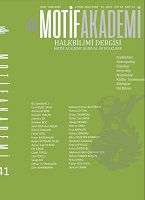ANADOLU MASALLARINDAKİ YASAK (TABU) MOTİFLERİNİN KÜLTÜREL UNSURLAR AÇISINDAN İNCELENMESİ
EXAMINING THE BAN (TABOO) MOTIVE IN THE ANATOLIA FOLKTALES IN TERMS OF CULTURAL ASPECTS
Author(s): İbrahim BozSubject(s): Customs / Folklore, Turkish Literature, Cultural Anthropology / Ethnology, Culture and social structure
Published by: Motif Halk Oyunları Eğitim ve Öğretim Vakfı
Keywords: Narrative; Anatolia folktales; motif; ban motif; cultural codes;
Summary/Abstract: It is possible to find the aspects in the folktales, which are the oral narratives that include the cultural codes of a nation, regarding the language, daily life, and the cultural features of the locality where they were produced. Accordingly, folktales assume an important functions in carrying the cultural memory to the future generations. The folktale motives are the minor features that are repeated in many folktales, usually extraordinary, and bearing the features of the culture in which they are formed. Thus, the motives are influential in the formation of the plot, appearence of the events and the characters, and transmitting the cultural codes. Additionally, there is a firm relation between these motives, and one motive assumes an intermediary role in the formation of another one. In this work, the ban (taboo) motive was examined from the Motif Index. First the concepts of folktale and motif were visited. Then, we sruveyed the books Zaman Zaman İçinde and Az Gittik Uz Gittik by Pertev Naili Boratav, and examined the folktales Bacı Bacı Can Bacı, Yedi Kardeşler, Dülger Kızı, Yıldırım Padişahı, Dünya Güzeli, Yeraltı Diyarının Kartalı that appear in these books and contain the ban motif. We tried to find out if the ban motives in these narratives bear the cultural codes. We additionally visited their influence on the development of the plot and the diversity of the characters. As Vladimir Propp mentioned in his work Masalın Biçimbilimi (Morphology of the Folktale), we observed that ban was always absolutely broken. After the breaking of the ban, the hero get in big troubles, and is made subject to trial(s) to overcome those troubles. Thus, the ban motif is instrumental in the appearence of the other motives and the partition of other events/characters to the narrative. It was also detected that the ban motives that appear in the Anatolian folktales contain the cultural codes, and that such codes are used for the surrogacy function.
Journal: Motif Akademi Halkbilimi Dergisi
- Issue Year: 16/2023
- Issue No: 41
- Page Range: 69-81
- Page Count: 13
- Language: Turkish

